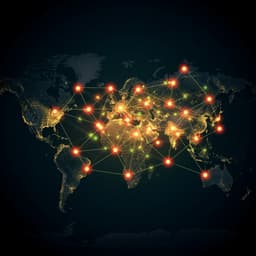
Environmental Studies and Forestry
The socioeconomic and environmental niche of protected areas reveals global conservation gaps and opportunities
D. Mouillot, L. Velez, et al.
Explore how the global ambition for 30% protected areas by 2030 is challenged by uneven distribution. This study by David Mouillot and colleagues delves into the socioeconomic and environmental factors influencing the establishment of terrestrial and marine protected areas, revealing surprising clusters where conservation efforts struggle against human development.
~3 min • Beginner • English
Introduction
Protected areas (PAs) are central tools to buffer biodiversity loss and support human well-being, but their benefits can be limited by weak regulations, financial constraints, and social conflicts. Despite increased PA coverage (over 17% terrestrial and 8% marine) and the Kunming–Montreal Global Biodiversity Framework target to protect at least 30% of land and sea by 2030, protection is uneven and often biased towards wealthier nations and areas less valuable for production, potentially undermining biodiversity, equity, and climate goals. The study’s central question is which socioeconomic and environmental conditions enable or hinder PA establishment globally, and how these conditions shape where new, especially highly restrictive (IUCN I) PAs can feasibly be created. The authors aim to quantify a global ‘niche’ for PAs using 14 social-environmental factors and to predict the relative likelihood of PA occurrence. They then overlay these predictions with vertebrate distributions to locate where conservation gains are both high and realistically attainable versus high but unrealistic, providing guidance for strategic, context-aware conservation expansion.
Literature Review
Prior work shows PA designations often favor high-income countries and remote, less economically valuable areas, leading to environmental and socioeconomic gaps and underrepresentation of key habitats, species, and regions (e.g., islands, high elevations, and the tropics). Studies have linked PA establishment to geopolitical conflicts, human development, land use, cultural context, and elevation, but other potential levers and barriers (e.g., dependence on natural resources, density of environmental NGOs) are less examined. There is also recognition of biases in marine PA siting favoring ease of establishment and residual areas, and concerns that protection coverage ignores social context and costs, potentially limiting poverty alleviation, climate mitigation, and species conservation outcomes.
Methodology
Study design: A global 10×10 km grid was created across terrestrial and marine realms. Cells overlapping IUCN-recognized PAs (categories I–VI) were labeled protected; an equal number of non-overlapping cells were randomly sampled as unprotected to achieve a balanced design. Marine cells were constrained to exclusive economic zones (EEZs). Final sample sizes: 517,450 terrestrial and 421,746 marine cells.
Predictor variables: Fourteen factors per cell were compiled (Pearson correlations between −0.7 and 0.7). Socioeconomic (local: GDP, accessibility to nearest city, human footprint; national: HDI, number of conflicts, number of NGOs, dependency on natural resources). Environmental (shared: island, annual temperature, primary productivity; terrestrial: elevation, precipitation, freshwater coverage, distance to coast; marine: depth, distance to seamounts/knolls, sea surface salinity, distance to coast). Missing values (0.7% land, 1.2% sea) were imputed with missForest.
Exploratory niche visualization: Ecological Niche Factor Analysis (ENFA) on the 14-factor space contrasted protected vs. unprotected cells and across IUCN categories to reveal underrepresented social-environmental conditions.
Modeling PA likelihood: Presence–background data were modeled with Random Forest (RF; ranger, 500 trees) to estimate relative likelihood of PA occurrence (all IUCN and IUCN I separately) for land and sea. To enable probabilistic interpretation and avoid overfitting, RF outputs were calibrated via binomial GAMs to yield continuous 0–1 relative likelihoods.
Validation and spatial blocking: To mitigate spatial autocorrelation and PA contiguity effects, 10-fold spatial cross-validation used spatially independent blocks with a conservative 1000 km minimum separation (blockCV). Model performance was assessed by accuracy and true skill statistic (TSS). Residual spatial autocorrelation was tested with Moran’s I. Variable importance used permutation AUC loss (varImpRanger); partial dependence plots summarized marginal effects.
Sensitivity analyses: To test robustness, models were re-fit after removing (i) the largest PAs (>10% of protected area), (ii) PAs from countries in the bottom 10% HDI (possible underreporting), and (iii) PAs from top 10% HDI countries (possible overrepresentation), for all-PAs and IUCN I models.
Biodiversity data: Terrestrial vertebrates: IUCN mammals (n=5,529) and BirdLife breeding birds (n=10,709) rasterized to 10 km equal-area grid; removed EX/EW and primarily marine Spheniscidae. Marine fishes: OBIS occurrences processed and cleaned, species ranges reconstructed with convex polygons, partitioned to account for hemispheric/ocean discontinuities, depth-filtered to species’ known limits, supplemented with reef fish data; final 14,050 species aggregated to 1° grids.
Spatial prioritization: Zonation v4 (core-area algorithm) ranked unprotected cells by contribution to vertebrate representation (maximize range-size coverage and rare species occurrences), yielding a global priority hierarchy of unprotected areas.
Potential vs. unrealistic conservation gains: For unprotected cells and IUCN I focus, define potential gains as those in the top 10% biodiversity priority AND with relative likelihood of protection >90% (low-hanging fruit). Define unrealistic gains as top 10% biodiversity priority but with relative likelihood <10% (high-hanging fruit). Country-level mean relative likelihoods for converting unprotected areas to IUCN I were also mapped.
Key Findings
- PA distributions occupy only a subset of global socio-environmental space; the most restrictive PAs (IUCN I) cover an even smaller fraction, especially at sea, with strong clustering where HDI and NGO numbers are high and conflicts, human footprint, and resource dependency are low.
- Model performance for all IUCN categories: land accuracy 0.74 ± 0.02, TSS 0.47 ± 0.04; sea accuracy 0.88 ± 0.05, TSS 0.76 ± 0.09. Socioeconomic factors were generally more important than environmental ones (mean standardized importance land: 0.63 vs 0.59; sea: 0.66 vs 0.43). National socioeconomic factors outweighed local ones (land: 0.81 vs 0.47; sea: 0.69 vs 0.56).
- For IUCN I only: land accuracy 0.91 ± 0.02, TSS 0.46 ± 0.06; sea accuracy 0.94 ± 0.03, TSS 0.64 ± 0.21. Dominant factors: land—HDI and temperature (importance >0.8); sea—accessibility (travel time) and temperature (importance >0.8).
- Partial responses: relative PA likelihood increases with HDI (notably above a threshold ~0.7), and with number of NGOs (marine boost above ~50 NGOs); decreases with conflicts, human footprint, dependence on natural resources, distance to coast, and higher annual temperature. Elevation positively relates to terrestrial PAs; depth negatively relates to marine PAs, indicating coastal and pelagic protection gaps within EEZs. Accessibility is a strong negative for marine IUCN I; no clear accessibility effect on land.
- Country-level feasibility (IUCN I conversion of unprotected areas): only some European countries and New Zealand exceed a mean >50% likelihood on land; most countries are <10%, with exceptions including parts of North America, Australia, Botswana, Japan, and Mongolia. At sea, mean likelihoods are <10% for most countries, with higher values in a few (e.g., Chile, Mexico), suggesting strong challenges to expand fully protected MPAs to >10%.
- Potential vs. unrealistic gains: On land, potential high gains cluster along the North Pacific coast of the Americas, Amazonia, Southern Australia, and Northern Asia; Europe shows favorable enabling conditions but lower biodiversity priority, implying low gains. Unrealistic but high gains dominate in South Asia, Africa, and South America, where biodiversity priorities are high but enabling conditions are poor.
- At sea, potential high gains are scarce (notably Eastern Pacific and NE Australia), while unrealistic high gains are widespread along many national coasts (Africa, Asia, Americas), except Australia and parts of Northern Europe, underscoring few near-term opportunities for fully protected MPAs in high-priority marine areas.
Discussion
By formalizing a multidimensional socio-environmental niche for PAs and predicting relative likelihoods of establishment, the study explains the heterogeneous and clustered global distribution of PAs as a function of enabling conditions, particularly national-level socioeconomic context. The findings highlight key levers (higher HDI, strong civil society/NGO presence) and barriers (conflicts, high human footprint, dependence on natural resources, low accessibility at sea) that shape where new PAs—especially restrictive ones—are feasible. Differences between land and sea are pronounced: restrictive terrestrial PAs can occur even in more populated contexts when national conditions are favorable, whereas marine restrictive PAs face substantial barriers near coasts where biodiversity gains would be highest. Overlaying predicted feasibility with vertebrate conservation priorities reveals spatial mismatches—many biodiversity-rich places have low feasibility for PA establishment—suggesting that relying solely on PA expansion may not achieve global biodiversity targets. Alternative, more inclusive and context-appropriate strategies (e.g., OECMs, PPAs, regional cooperation, improved governance capacity) are needed to unlock conservation outcomes where strict PAs are unlikely in the near term.
Conclusion
Socioeconomic context—especially national development, governance, and civil society capacity—largely determines where PAs, and particularly IUCN I areas, are established. Machine learning models using 14 socio-environmental factors accurately predict the relative likelihood of PA occurrence across land and sea, revealing large global conservation gaps and few marine ‘low-hanging fruits’. Mapping potential versus unrealistic gains shows where strict protection could yield substantial vertebrate benefits and where it is improbable given current conditions. Achieving the 30% coverage target by 2030, including 10% fully protected, is unlikely without overcoming socioeconomic barriers and deploying complementary tools (OECMs, PPAs) and cooperative mechanisms to support countries with unfavorable contexts. Future work should explore temporal dynamics of enabling conditions, causal pathways (e.g., roles of NGOs and governance), and evaluate the effectiveness of alternative conservation measures to ensure equitable and durable biodiversity outcomes.
Limitations
The study uses presence–background data and models relative likelihood rather than true probabilities. NGO and other socioeconomic associations are correlational, not causal. Some PAs may be missing or misclassified in global databases (e.g., underreporting in low-HDI countries), potentially biasing patterns, though sensitivity analyses suggest robustness. Models are spatially cross-validated but remain static in time, not capturing temporal trajectories of development, governance, or land/sea use. Biodiversity inputs rely on range maps and occurrence data (e.g., OBIS) with known sampling and resolution limitations (e.g., 10 km for terrestrial vertebrates; 1° for fishes) that may affect prioritization. Calibration and imputation (missForest) introduce additional uncertainty. The classification of ‘potential’ and ‘unrealistic’ gains depends on chosen thresholds (top 10% priority; >90% or <10% likelihood) and may shift with alternative criteria.
Related Publications
Explore these studies to deepen your understanding of the subject.







